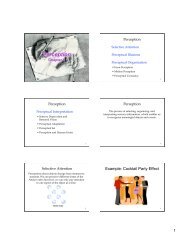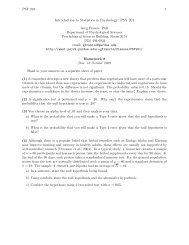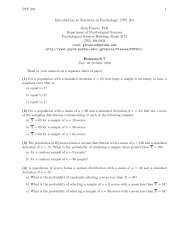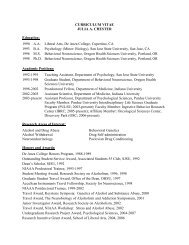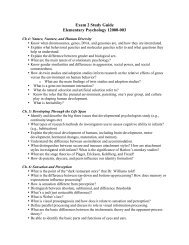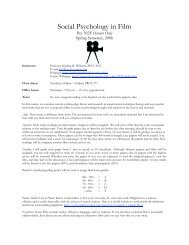Learning - Department of Psychological Sciences
Learning - Department of Psychological Sciences
Learning - Department of Psychological Sciences
You also want an ePaper? Increase the reach of your titles
YUMPU automatically turns print PDFs into web optimized ePapers that Google loves.
To What Does <strong>Learning</strong> Apply?• Information (for exams)• Skills– Sports– Vocational• Hobbies and Interests– Gambling• Fears• Rituals, behavioral predispositions (personality?)• Beliefs• Values• Social behavior (how to behave among others)• Attitudes, stereotypes, prejudices7How Do We Learn?We learn by association. Our mindsnaturally connect events that occur insequence.2000 years ago, Aristotle suggested thislaw <strong>of</strong> association. Then 200 years agoLocke and Hume reiterated this law.8Stimulus-Stimulus <strong>Learning</strong><strong>Learning</strong> to associate one stimuluswith another.Stimulus-Stimulus <strong>Learning</strong><strong>Learning</strong> to associate one stimuluswith another.910Response-Consequence <strong>Learning</strong>Response-Consequence <strong>Learning</strong><strong>Learning</strong> to associate a responsewith a consequence.<strong>Learning</strong> to associate a responsewith a consequence.11122
Classical ConditioningIdeas <strong>of</strong> classical conditioning originate from oldphilosophical theories. However, it was theRussian physiologist Ivan Pavlov who elucidatedclassical conditioning. His work provided a basisfor later behaviorists like John Watson and B. F.Skinner.Pavlov’s ExperimentsBefore conditioning, food (UnconditionedStimulus, US) produces salivation(Unconditioned Response, UR). However, thetone (neutral stimulus) does not.SovfotoIvan Pavlov (1849-1936)1314Pavlov’s ExperimentsDuring conditioning, the neutral stimulus (tone)and the US (food) are paired, resulting insalivation (UR). After conditioning, the neutralstimulus (now Conditioned Stimulus, CS) elicitssalivation (now Conditioned Response, CR)AcquisitionAcquisition is the initial stage in classicalconditioning in which an association between aneutral stimulus and an unconditionedstimulus takes place.In most cases, for conditioning to occur, theneutral stimulus needs to come before theunconditioned stimulus.The time in between the two stimuli shouldbe about half a second.1516AcquisitionThe CS needs to come half a second before the USfor acquisition to occur.ExtinctionWhen the US (food) does not follow the CS(tone), CR (salivation) begins to decrease andeventually causes extinction.17183
Spontaneous RecoveryAfter a rest period, an extinguished CR (salivation)spontaneously recovers, but if the CS (tone) persistsalone, the CR becomes extinct again.Stimulus GeneralizationTendency to respond tostimuli similar to the CS iscalled generalization.Pavlov conditioned thedog’s salivation (CR) byusing miniature vibrators(CS) on the thigh. When hesubsequently stimulatedother parts <strong>of</strong> the dog’sbody, salivation dropped.1920Stimulus DiscriminationDiscrimination is the learned ability to distinguishbetween a conditioned stimulus and other stimuli thatdo not signal an unconditioned stimulus.Extending Pavlov’s UnderstandingPavlov and Watson considered consciousness,or mind, unfit for the scientific study <strong>of</strong>psychology. However, they underestimatedthe importance <strong>of</strong> cognitive processes andbiological constraints.2122Cognitive ProcessesEarly behaviorists believed that learnedbehaviors <strong>of</strong> various animals could be reducedto mindless mechanisms.StimulusBlack BoxResponseHowever, later behaviorists suggested thatanimals learn the predictability <strong>of</strong> a stimulus,meaning they learn expectancy or awareness <strong>of</strong> astimulus (Rescorla, 1988).Biological PredispositionsPavlov and Watson believed that laws <strong>of</strong>learning were similar for all animals.Therefore, a pigeon and a person do not differin their learning.However, behaviorists later suggested thatlearning is constrained by an animal’s biology(i.e., Robert Bolles and “species-specificdefense reactions”).23244
Biological PredispositionsBiological PredispositionsEven humans can develop classically toconditioned nausea.The bright and noisy water studies.Garcia showed that the durationbetween the CS and the US may belong (hours), but yet result inconditioning. A biologically adaptiveCS (taste) led to conditioning and notto others (light or sound).John GarciaCourtesy <strong>of</strong> John Garcia2526Pavlov’s LegacyPavlov’s greatest contributionto psychology is isolatingelementary behaviors frommore complex ones throughobjective scientificprocedures.Applications <strong>of</strong> ClassicalConditioningAlcoholics may be conditioned (aversively)by reversing their positive-associations withalcohol.Through classical conditioning, a drug (plusits taste) that affects the immune responsemay cause the taste <strong>of</strong> the drug to invoke theimmune response.Ivan Pavlov(1849-1936)27A Clockwork Orange28Applications <strong>of</strong> ClassicalConditioningTwo Famous John Watson QuotesWatson used classicalconditioning procedures todevelop advertisingcampaigns for a number <strong>of</strong>organizations, includingMaxwell House, making the“c<strong>of</strong>fee break” an Americancustom.See also, “Little Albert” experimentJohn Broadus Watson29Brown Brothers• “Psychology as the behaviorist views it is a purely objective experimental branch<strong>of</strong> natural science. Its theoretical goal is the prediction and control <strong>of</strong> behavior.Introspection forms no essential part <strong>of</strong> its methods, nor is the scientific value <strong>of</strong>its data dependent upon the readiness with which they lend themselves tointerpretation in terms <strong>of</strong> consciousness. The behaviorist, in his efforts to get aunitary scheme <strong>of</strong> animal response, recognizes no dividing line between manand brute. The behavior <strong>of</strong> man, with all <strong>of</strong> its refinement and complexity, formsonly a part <strong>of</strong> the behaviorist's total scheme <strong>of</strong> investigation.”• “Give me a dozen healthy infants, well-formed, and my own specifiedworld to bring them up in and I'll guarantee to take any one at randomand train him to become any type <strong>of</strong> specialist I might select -- doctor,lawyer, artist, merchant-chief and, yes, even beggar-man and thief,regardless <strong>of</strong> his talents, penchants, tendencies, abilities, vocations,and race <strong>of</strong> his ancestors. I am going beyond my facts and I admit it,but so have the advocates <strong>of</strong> the contrary and they have been doing itfor many thousands <strong>of</strong> years.”(1930)305
Operant & Classical Conditioning1. Classical conditioningforms associationsbetween stimuli (CSand US). Operantconditioning, on theother hand, forms anassociation betweenbehaviors and theresulting events.Operant & Classical ConditioningClassical conditioning involves respondentbehavior that occurs as an automaticresponse to a certain stimulus. Operantconditioning involves operant behavior, abehavior that operates on the environment,producing rewarding or punishing stimuli.3132Skinner’s ExperimentsSkinner’s experiments extend Thorndike’sthinking, especially his law <strong>of</strong> effect. This lawstates that rewarded behavior is likely to occuragain.33Yale University LibraryOperant ChamberUsing Thorndike's law <strong>of</strong> effect as a startingpoint, Skinner developed the Operant chamber,or the Skinner box, to study operantconditioning.Walter Dawn/ Photo Researchers, Inc.34From The Essentials <strong>of</strong> Conditioning and <strong>Learning</strong>, 3 rdEdition by Michael P. Domjan, 2005. Used with permissionby Thomson <strong>Learning</strong>, Wadsworth DivisionOperant ChamberShapingThe operant chamber,or Skinner box, comeswith a bar or key thatan animal manipulatesto obtain a reinforcerlike food or water. Thebar or key is connectedto devices that recordthe animal’s response.35Shaping is the operant conditioning procedurein which reinforcers guide behavior towards thedesired target behavior through successiveapproximations.Khamis Ramadhan/ Panapress/ Getty ImagesA rat shaped to sniff mines. A manatee shaped to discriminateobjects <strong>of</strong> different shapes, colors and sizes.Fred Bavendam/ Peter Arnold, Inc.366
Types <strong>of</strong> ReinforcersAny event that strengthens the behavior itfollows. A heat lamp positively reinforces ameerkat’s behavior in the cold.<strong>Learning</strong> to Bar Press:Shaping through SuccessiveApproximationsReuters/ Corbis3738Add or GiveTake Away orRemoveRewards & PunishmentsSomethingDesirablePositiveReinforcementNegativePunishment(i.e., time-out)SomethingAversivePositivePunishmentNegativeReinforcementPrimary & Secondary ReinforcersPrimary Reinforcer: An innately reinforcingstimulus like food or drink.Conditioned Reinforcer: A learnedreinforcer that gets its reinforcing powerthrough association with the primaryreinforcer.3940Immediate & Delayed ReinforcersReinforcement SchedulesImmediate Reinforcer: A reinforcer thatoccurs instantly after a behavior. A rat getsa food pellet for a bar press.Delayed Reinforcer: A reinforcer that isdelayed in time for a certain behavior. Apaycheck that comes at the end <strong>of</strong> a week.We may be inclined to engage in small immediatereinforcers (watching TV) rather than large delayedreinforcers (getting an A in a course) which require1. Continuous Reinforcement: Reinforces thedesired response each time it occurs.2. Partial Reinforcement: Reinforces aresponse only part <strong>of</strong> the time. Though thisresults in slower acquisition in thebeginning, it shows greater resistance toextinction later on.consistent study. 41427
Ratio SchedulesFixed-ratio schedule: Reinforces a responseonly after a specified number <strong>of</strong> responses.e.g., piecework pay.Variable-ratio schedule: Reinforces aresponse after an unpredictable number <strong>of</strong>responses. This is hard to extinguish because<strong>of</strong> the unpredictability. (e.g., behaviors likegambling, fishing.)Interval Schedules Fixed-interval schedule: Reinforces aresponse only after a specified time haselapsed. (e.g., preparing for an examonly when the exam draws close.) Variable-interval schedule: Reinforces aresponse at unpredictable timeintervals, which produces slow, steadyresponses. (e.g., pop quiz.)4344Schedules <strong>of</strong> ReinforcementPunishmentAn aversive event that decreases the behavior itfollows.4546PunishmentExtending Skinner’s UnderstandingAlthough there may be some justification foroccasional punishment (Larzelaere & Baumrind,2002), it usually leads to negative effects.1. Results in unwanted fears.2. Conveys no information to the organism as to what to do.3. Justifies pain to others.4. Causes unwanted behaviors to reappear in its absence.5. Causes aggression towards the agent.6. Causes one unwanted behavior to appear in place <strong>of</strong>another.47Skinner believed in inner thought processes andbiological underpinnings, but manypsychologists criticize him for discountingthem.488
Cognition & Operant ConditioningEvidence <strong>of</strong> cognitive processes during operantlearning comes from rats during a mazeexploration in which they navigate the mazewithout an obvious reward. Rats seem todevelop cognitive maps, or mentalrepresentations, <strong>of</strong> the layout <strong>of</strong> the maze(environment).Latent <strong>Learning</strong>Such cognitive maps are based on latentlearning, which becomes apparent when anincentive is given (Tolman & Honzik, 1930).4950MotivationBiological PredispositionIntrinsic Motivation:The desire to perform abehavior for its ownsake.Extrinsic Motivation:The desire to perform abehavior due topromised rewards orthreats <strong>of</strong> punishments.Biological constraintspredispose organisms tolearn associations thatare naturally adaptive.Breland and Breland(1961) showed thatanimals drift towardstheir biologicallypredisposed instinctivebehaviors.Marian Breland BaileyPhoto: Bob Bailey5152Skinner’s LegacySkinner argued that behaviors were shaped byexternal influences instead <strong>of</strong> inner thoughts andfeelings. Critics argued that Skinnerdehumanized people by neglecting their free will.Applications <strong>of</strong> OperantConditioningSkinner introduced the concept <strong>of</strong> teachingmachines that shape learning in small steps andprovide reinforcements for correct rewards.Falk/ Photo Researchers, Inc.53In SchoolLWA-JDL/ Corbis549
Applications <strong>of</strong> OperantConditioningReinforcement principles can enhance athleticperformance.Applications <strong>of</strong> OperantConditioningReinforcers affect productivity. Many companiesnow allow employees to share pr<strong>of</strong>its andparticipate in company ownership.In Sports55At work56Applications <strong>of</strong> OperantConditioningOperant vs. Classical ConditioningIn children, reinforcing good behavior increases theoccurrence <strong>of</strong> these behaviors. Ignoring unwantedbehavior decreases their occurrence (time-out).Still, ignoring has other negative consequences that makeit aversive; not just removing positive attention5758<strong>Learning</strong> by Observation:Social <strong>Learning</strong>Mirror NeuronsHigher animals,especially humans,learn through observingand imitating others.© Herb TerraceNeuroscientists discovered mirror neurons inthe brains <strong>of</strong> animals and humans that are activeduring observational learning.The monkey on theright imitates themonkey on the left intouching the pictures ina certain order to obtaina reward.©Herb TerraceReprinted with permission from the AmericanAssociation for the Advancement <strong>of</strong> Science,Subiaul et al., Science 305: 407-410 (2004)© 2004 AAAS.596010
Imitation OnsetBandura's Experiments<strong>Learning</strong> by observationbegins early in life. This14-month-old childimitates the adult on TVin pulling a toy apart.Meltz<strong>of</strong>f, A.N. (1998). Imitation <strong>of</strong> televised models by infants.Child Development, 59 1221-1229. Photos Courtesy <strong>of</strong> A.N. Meltz<strong>of</strong>f and M. Hanuk.Bandura's Bobo dollstudy (1961) indicatedthat individuals(children) learnthrough imitatingothers who receiverewards andpunishments.Courtesy <strong>of</strong> Albert Bandura, Stanford University6162Applications <strong>of</strong> Observational<strong>Learning</strong>Unfortunately, Bandura’sstudies show thatantisocial models (family,neighborhood or TV), ifreinforced, may haveantisocial effects.Positive Observational <strong>Learning</strong>Fortunately, prosocial (positive, helpful) modelsmay have prosocial effects.63Bob Daemmrich/ The Image Works64Television and Observational<strong>Learning</strong>Gentile et al., (2004)shows that children inelementary schoolwho are exposed toviolent television,videos, and videogames expressincreased aggression.Ron Chapple/ Taxi/ Getty Images65Modeling ViolenceResearch shows that viewing reinforced media violenceleads to an increased expression <strong>of</strong> aggression.Bob Daemmrich/ The Image WorksChildren modeling after pro wrestlersGlassman/ The Image Works6611


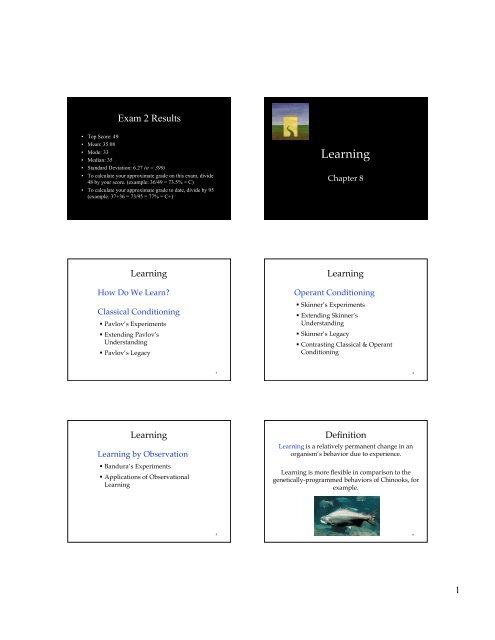
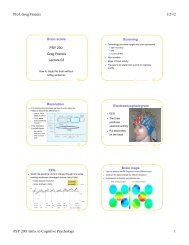

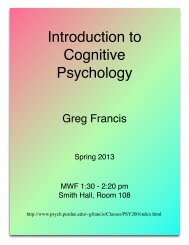
![Exam 4 Study Guide[1]](https://img.yumpu.com/45196739/1/190x245/exam-4-study-guide1.jpg?quality=85)
